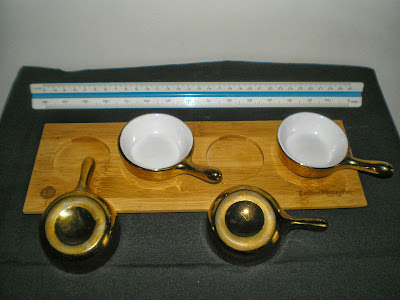Designer
|
Not Known
|
Maker
|
Made for Luke Nguyen by Baccarat
|
Marks
|
No marks on ramekins. Name “Luke Nguyen” printed on bottom
right-hand corner of platter; initials “LG” to left hand corner.
|
Material
|
Ramekins; Soft paste porcelain,
22ct gold to handle and exterior, Platter is laminated bamboo.
|
Description
|
Gilded bowl with white gloss
glazed interior slightly indented footring base dimpled inwards from
footring.
|
Condition
|
Good, some wear to gilding on footring
|
Number
|
No number
|
Production Date
|
Early 2000s
|
Width at rim
|
60mm
|
Width at base
|
40mm
|
Depth
|
23mm
|
Length (with handle)
|
97mm
|
Weight
|
90 gm
|
Volume
|
35 mm
|
Acquisition
|
Purchase
Salvo Stores, Noble Park
30th September 2013
|
Rameking Reference Number
|
LNG 001-004
|
These four little ramekins form a tasting
sampler platter. These platters are
used in some restaurants for patrons to try various dishes. These were made for Australian restaurateur
Luke Nguyen by Baccarat cookware, a brand of Playgroup Pty Ltd located in St Kilda Road, Melbourne. Tasting samplers are made for other purposes, such as for holding small glasses of different beers.
Luke is an award winning Sydney
Restaurateur and Chef (at the “Red Lantern” restaurant in Surrey Hills). He is also an author of several books on
cooking and has hosted a television series on Vietnam and its food. Luke was born in a refugee camp in Thailand
in 1978 to Vietnamese parents who had fled the country some months earlier. He has also apperared as a guest chef on the
television show Masterchef, season 2., and “Masterchef Vietnam”. He also takes tour groups to Vietnam to
experience their cuisine and learn to cook it.
In partnership, he founded the “Little Lantern Foundation” giving
disadvantaged youth training in the hospitality industry.

Lustre Gold ramekins like these are press-moulded
soft paste porcelain with 22 Carat gold applied to the exterior of the
bowl. Gilding, as it is known, on
pottery is a complex and difficult method to learn and can be done using
several differing methods. Over five
tonnes of gold are still used each year to gild ceramics. Gold can be sprayed, brushed,
screen-printed, acid etched or mixed with resin. Early methods involved mixing the gold with mercury or honey
giving the body a bright rich honey gold colour when fired at a relatively low
temperature. Ancient gilding on the
wood of Egyptian mummy cases is still as bright as original.
The method most used commonly for lining ceramics with gold is to mix gold powder
and borax (borosilicate or a bismuth based flux). The resulting powder is brushed onto the pottery with a very fine
brush (usually camel hair). When the
mixture dries, because it is mixed with water it is fired, during which the
borax is burnt off and the gold melts into the body. The pottery comes out brown and must be burnished (polished) with
a stone, usually agate to bring out the gold colour.
Any further information would be appreciated. maybe Luke can get in touch?
One of the
things that I have often lamented on this blog has been the loss of industry as
a result of Government policy and imports.
In the case of Royal Worcester, had it not been for the collapse of the
glove making industry in Worcester in the mid 18th Century, Royal
Worcester would not have come into being.
A number of local businessmen got together and decided to start a
pottery.
One of the
things that I have often lamented on this blog has been the loss of industry as
a result of Government policy and imports.
In the case of Royal Worcester, had it not been for the collapse of the
glove making industry in Worcester in the mid 18th Century, Royal
Worcester would not have come into being.
A number of local businessmen got together and decided to start a
pottery.
One of the
things that I have often lamented on this blog has been the loss of industry as
a result of Government policy and imports.
In the case of Royal Worcester, had it not been for the collapse of the
glove making industry in Worcester in the mid 18th Century, Royal
Worcester would not have come into being.
A number of local businessmen got together and decided to start a
pottery.
One of the
things that I have often lamented on this blog has been the loss of industry as
a result of Government policy and imports.
In the case of Royal Worcester, had it not been for the collapse of the
glove making industry in Worcester in the mid 18th Century, Royal Worcester
would not have come into being. A
number of local businessmen got together and decided to start a pottery.





Thank you for this nice list . this article is awesome and really helpful and everyone can use it as a reference to build backlinks
ReplyDelete카지노사이트